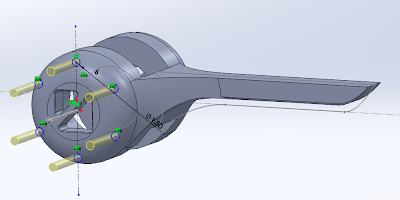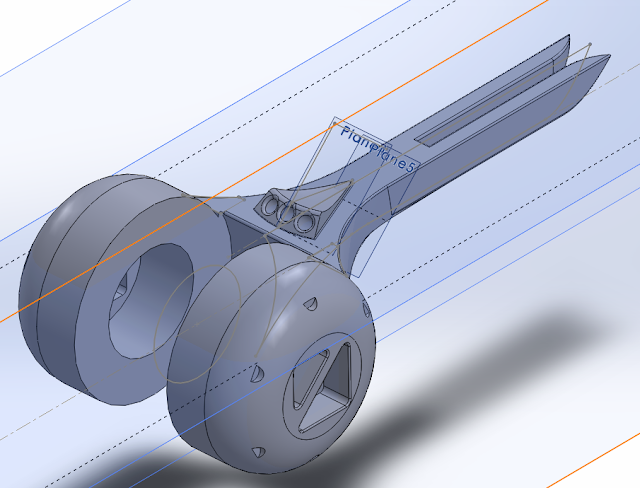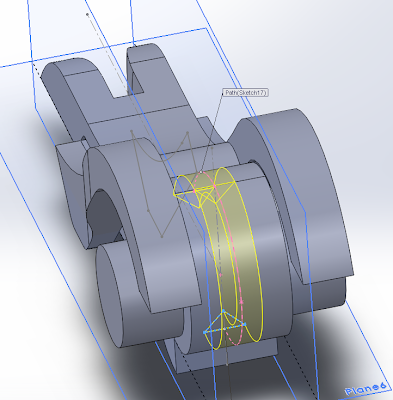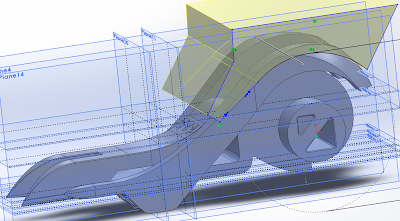The part of the model that I started on first was the lesser of the two large segments. This piece involves the part of the model that "latches on" to the other half, surrounding the extruded axle with circular segments that will allow it to move.
This half is the part that draws a lot from the architectural precedent, in the way that the extrusion grows out of the central point. One of the elements that I also wanted to incorporate into this joint was the idea that it wasn't built, but rather grown, along a very simple geometric formula. The curves build the idea of an organic element, but ultimately they are still controlled and dictated by the linear elements of the model.
One of the parts that I wanted to build in were the pieces that the Bubble ship incorporated. I really liked the hexagonally symmetrical air vents. Now obviously my model doesn't need air vents, but as a subtle little aesthetic, they can work quite nicely.
I wanted to split the main section in two, so as to allow the model to have an architecturally senseless but graceful air. The architecture precedent really played on this idea of "Does that even really fit people in it??", but it looked incredible and just oozed pure futurism. The subtle curvature used in combination with the featuresque curvature really played on the idea of challenging the angularity as well as submitting to it.
One of the final elements that I built into this part was the slot going all the way through, an element that I had involved right from the beginning of the sketch. The double rounded triangles are a form that I've seen somewhere before, but I can't quite place where. The give the user a point of reference on the main form for the rotation as well as being aesthetic.
Another piece that I had to build into the model was a set of holes that pierce through the model, allowing for the elastic thread I've bought to be put through the model. This hole then transforms to a bigger hole on the far side of the model, so that I can attach a crimp to the thread, and then let the crimp fall back into the hole, so that there's no extraneous pieces of thread hanging around.
Part 2 is the much more extensive and tricky part to do, since it contains far more elements and therefore I need to give it more consideration. I started with the overarching curve and the spiral inner curve, which would allow the knee cap part to slide into the joint a little bit. This little consideration is really important in capturing the motion as a collective motion of multiple parts.
Once I had the overarching curve that would act as the stop for the bottom half of the joint, the rest of the top half could come together. I this step I really tried to capture the basic form I was going for. Lots of extrusions and perfect measurements needed to be made. For this piece to get the aesthetic I wanted, I wanted it to feel like it was a whole range of separate pieces coming together, but working as one.
This half of the model I also split into two at the end, so as to establish a connection between that half and the other half. This also creates a suggestion for where to hold the model, as the spaces create an edge that is comfortable to hold. For the knee joint to sit comfortably in place and actually stay in its place, it really needs to have a sort of rail, which I incorporated into the spiral edge.
One of the coolest elements that I built into this part of the model is the diagonal slope on the front curvature. It's quite a striking addition (or subtraction, technically!) and I really feel like it makes the model have a much more organic feel to it, with a combination of the harder lines and the stranger angled edges.
I then worked a little more on creating some additions to the overall shape, as well as making the model lose a bit of fat overall. One of the things that my tutor told me to experiment with was to remove some matter, making some more interesting surfaces visible.Again, most of the ideas for this element came from the feature wall in the Mass Effect architecture.
Once I had a concrete, workable form for the top half of the joint, I needed to come up with a solution for how to allow my elastic threads to fit into the model. I could have done the same thing that I did to the bottom half and have a top section that allowed the thread to fit into there. But I thought that since I just added a section in the space beneath the two bottom angular sections, I should use that area, as it would mean I'd have to put the thread through the model in a very interesting way.
Once I had that section working well, I decided to slim down the top overarching stopper curves, as they were a little fat now that I'm trying to refine the form into something a bit more elegant. The loss of matter and general filleting of some of the edges I wanted to smooth has allowed me to embody the images I've explored in this form.
This form is probably the more interesting one out the two main pieces so far, but that's okay. It's the half that's got a bigger role to play, so it deserves more attention. I managed to really slim it down by highlighting some interesting edges and the like, so it's good that I've been able to bring those out more.
The edges that I've exposed and made definitely put this form into a futuristic feel, and I think they make the model shine.
The next element I have to design is the knee cap. It has to be a subtle element, while at the same time still be a part that you notice, and actually see as being a working piece. The piece is going to have to be much more functional than aesthetic, since it's rather small.
Once I get to see it all together, it actually looks pretty sweet! Once I put all the parts together as an assembly, I did a motion study, and the pieces very much emulate the actual range of motion that the knee has. Which is very exciting.
Time to do some little prints!

















No comments:
Post a Comment